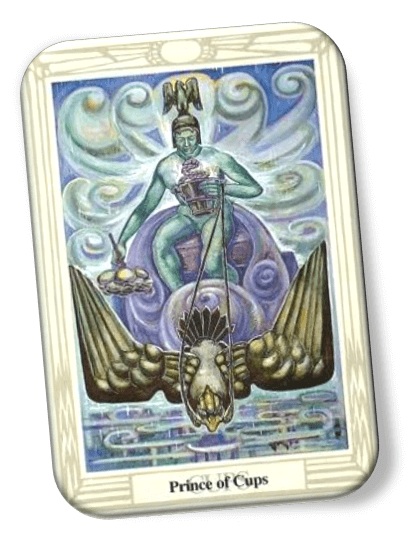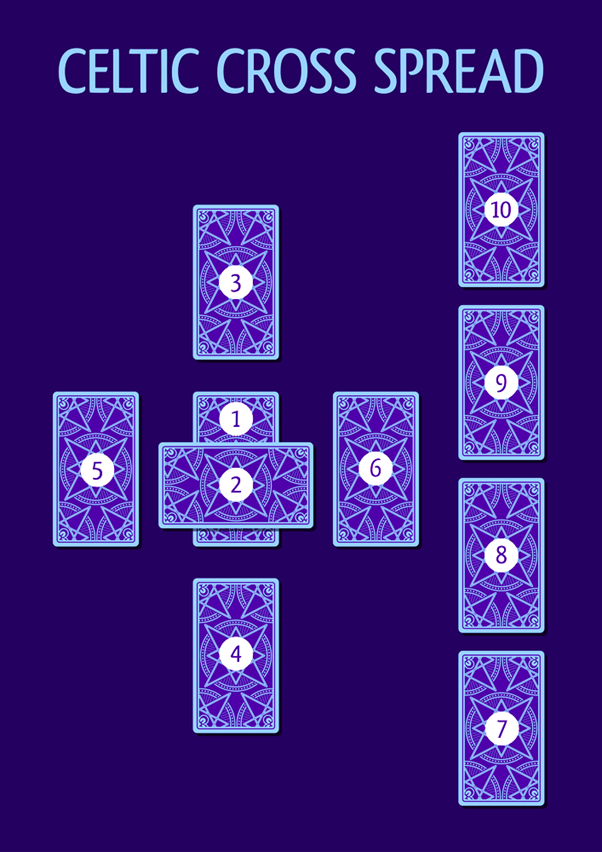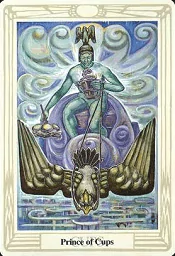Prince of Cups Thoth – Crowley Tarot | Thoth Tarot Deck
| Sacrifice and dedication. | |
| Connect with the Upper Self (the statue of the Lord crucified on the cross = "return to father"). | |
| Love, sympathy, sincerity, warmth. | |
| Selfish, lack of sensitivity, innocence. | |
| The bridge between emotion and reason. |

Son of transformation
Menu of Contents
I. Analyze and describe the Prince of Cups Thoth Tarot
1. Image
We see a naked warrior wearing a winged hat sitting on a chariot pulled by the eagle. Eagle represents rising from difficult physical conditions, in this card, it replaces for the scorpion that represents water element (scorpion freely passes on earthly things like the eagle). According to Crowley, this card describes the idea of depravity depicted indirectly in the image of stagnant water in a pond when it rains. The eagle represents a great will or lets the authority know our purpose; that is part of us that are reaching out endlessly, which leads us unconsciously.
By creating a bridge between the Mother (the water) and the Father (heaven), Prince is a water flow that can turn the suction force downward, which originates in deep places to become an advantage for him. By changing the incest of sin (longing for the mother) into an act of transformation and renewal (snake), he can reunite the ancient energies (Adam and Eva). The drooped lotus shows that this step has not been completed yet. If it blooms brightly above, it will represent the power to combine dark muddy pools with the beauty of bright heights.
Prince has not yet reconciled with the feminine part (inside him); he was still possessed by Siren’s love call (Princess of Cups Thoth card), signaling the desire to be held and the desire to pull him back to his original roots. Meanwhile, he was ready to set out for the Great Spirit, because “great will” (eagle) was pulling the scallop-shaped chariot (“eternal feminine”) that is free or confined outside of the “unconscious water” to the “cognitive paradise” (air connected to water).
2. Myth
This card does not represent the perfect man, but the one who endures, sacrifices, becomes the savior through his sacrifice. This corresponds to the story of the Holy Grail Knight, Lohengrin, the son of Parcival. He fought for Elsa von Brabant but had to leave her after the marriage because she, though strictly forbidden, still questioned him about the origin. Lohengrin, the messenger of the Holy Grail Castle, has always been enthusiastically helped by the knights, but as long as they can complete the good without being discovered, respond by rejecting the proposal when the Scorpion is in the highest position, also known as “the only salvation alliance of the ego”.
This signals the overcoming of the bigotry of ego and the desire to be led by a higher power. The development of the Prince has a profound influence, thereby discovering himself extremely in the act of salvation, which is the purpose of the transforming power represented by the image of the Scorpion.
II. The Prince of Cups: A Deeper Look into the Card’s Meaning and Symbolism
The Prince of Cups is one of the court cards in the Tarot’s suit of Cups. It is also known as the Knight of Cups in other decks. This card is often associated with the element of water, representing emotions, intuition, and creativity.
The Prince of Cups is a complex card, representing the union of opposites within the self. He is a symbol of emotional maturity and balance, with the ability to navigate the depths of the subconscious mind while remaining grounded in the physical world. He is also associated with creativity and artistic expression, and may indicate a need to explore one’s creative passions.
The imagery on the Prince of Cups card is rich in symbolism. The Prince is often depicted riding a white horse, representing purity and spiritual strength. He holds a cup in his hand, representing the emotional and intuitive aspects of the self. The cup may be overflowing with water, indicating an abundance of emotions or a need to express oneself creatively.
The Prince of Cups may also represent a person in one’s life who embodies the qualities of emotional maturity and artistic expression. This person may be a creative mentor or a romantic partner who inspires one to explore their emotional depths and express themselves creatively.
In a tarot reading, the Prince of Cups may indicate a need for emotional healing or a call to explore one’s creative passions. It may also represent a need for balance and harmony within the self, and the importance of embracing both the emotional and rational aspects of the self.
In conclusion, the Tarot card known as the Prince of Cups is intricate and multilayered. It stands for artistic expression, emotional development, and the fusion of internal opposites. Understanding the card’s symbolism and meaning can help us achieve better emotional and creative fulfillment while giving us deeper insights into the human experience.
III. Interpretation of the Prince of Cups Thoth Tarot
This card can represent people, in any field of life, but it can also be an experience in the field that corresponds in question.
1. Human
We come across the Knight of the Heart, a romantic spirit, a sensitive hero, a bodyguard of love, and a guardian of beautiful ideas, as well as tricky scammers and seductive liar. In short, this is a sensitive, warm and gentle guy, but can also be fake and unbelievable. In the case of the card representing women, it describes the masculine aspect of her being (animus).
2. Overview of the Prince of Cups Thoth Tarot
The winged Prince stood on a scalloped chariot pulled by the eagle, his hat also had an eagle symbol, representing the duty of water, his spirit was soaring to combine the emotional abyss with the height of awareness. With this concept, he demonstrates a period of development in which we face life challenges (not sinking again into deep water), still keeping in touch with our emotions (and there are no intellectually unrealistic ideas).
3. Awareness
During the time that this card represents, the main problem is recognizing our deep feelings (water), building them, and expressing them through words (air). This can show an inner search as well as expressing our emotions with a poem, a letter, or simply with a word.
4. Career
In terms of work, this card shows that one person effectively combines intuition (water) and awareness (air) together and therefore, this person not only sees new opportunities but also has knowledge and capacity to implement them. It can also represent someone who willing to be delegated by the community.
5. Sentiment
This card conveys imagination without borders reflected in all areas of emotional relationships. Under this impact, we respond very acutely in our emotional lives and tend to be ecstatic. In the upcoming romantic moments, we can immerse ourselves in warm emotions and make them become wildest: by loving gestures, a secret letter, an unusual invitation, or a very private gift.
IV. Similar correlations of the Prince of Cups Thoth Tarot
- Astrology – from 21⚬ Libra to 20⚬ Scorpion.
- Element – Air aspect of Water.
- I Ching – 49th Hexagram (Gé) – “Revolution”; 61st Hexagram (Zhóng Fù) – “Extremely sincere”.
- Human – Attractive, mysterious and profound guy.
- Similar objects – The Knight of the Holy Grail or another savior; Psyche’s atonement through the God of Love Amor and finally recognized as the God of Olympia.
- Sacred place – Saint Francis Church in Assisi (Italy).
- Sacred color – Blue-violet.
- Sacred Stone – Lapis lazuli, amethyst.
- Scent – Lotus.
V. Prince of Cups Thoth card in the upright and reverse
1. Upright Prince of Cups Thoth card
On the outside, it looks calm but this conceals a passion and intensity about him that can make him pleasant.
There are many things to give and great possibilities but cannot rely on (remember that he is not really an integrated whole).
His main responsibility is to himself, not to others.
He can be secretive and conceal the deepest desires, can be creative frequently in art or music.
Being easily identified with ups and downs in life and can use intuition (when they want to) to shed insight into other people’s lives because they have a completely immersed life.
2. Reversed Prince of Cups Thoth card
At his worst cruel, reckless and selfish
VI. Prince of Cups Thoth card in Celtic Cross spread

Card 1: Central Theme of the Spread – Are you engaged in the flow of life or holding back?
Card 2: Crossing Influences – need to come from your highest
merchandise and combine with.
Card 3: Subconscious Influences – the ambition to dominate rather than really understand yourself.
Card 4: Recent Past Affecting the Situation – extremely high and low periods.
Card 5: Hopes and Goals – to feel more turned on by life and excited to be alive, know yourself better and more balanced.
Card 6: Immediate Future – may be emotionally and spiritually intense, may need time to escape from these extremes.
Card 7: How you are affecting your situation – secretive and hide a fluctuation under a calm appearance; ambitious personality and follow the flow of life.
Card 8: How others are affecting your situation – a close and ambitious person who can be cruel and selfish
Card 9: Guidance or Warning – need to communicate more with your depth and not let ambition dominate you. Your friends and associative friends are important in guiding you to a more balanced life.
Card 10: Overall outcome – It just like an eagle that soars, you will have a much greater perspective on life-like the eagle but at what cost? You may have had lots of extreme highs and lows to get there and yet your potential is ever-present to be highly evolved spiritually (as represented by the association with John the Baptist discussed above).
Reading the Prince of Cups in combination with other cards in a Tarot spread can provide a more nuanced and complex understanding of the situation at hand. It can help to shed light on the underlying emotions, motivations, and desires that are driving the querent’s actions or decisions.
When interpreting complex Tarot spreads, it is important to consider the relationships between the cards, as well as the individual meanings of each card. The Prince of Cups may interact with other cards in various ways, depending on the context of the spread and the question being asked.
For example, if the Prince of Cups appears alongside the Ace of Swords, it may indicate a need for emotional clarity and clear communication. The Ace of Swords represents rational thought and mental clarity, while the Prince of Cups represents emotional depth and complexity. Together, they may suggest that the querent needs to balance their emotions with clear thinking and communication in order to resolve a situation.
If the Prince of Cups appears alongside the Ten of Swords, it may indicate a period of emotional pain or loss. The Ten of Swords represents a painful ending or betrayal, while the Prince of Cups represents deep emotions. Together, they may suggest that the querent needs to process their emotions and move towards healing and acceptance.
In a relationship reading, the Prince of Cups may interact with the cards that represent the querent and their partner. If the Prince of Cups appears alongside the Empress, it may indicate a deep emotional connection and a nurturing, supportive relationship. If it appears alongside the Five of Swords, however, it may indicate a relationship that is built on deception or power struggles.
Deciphering intricate Tarot spreads necessitates a thorough knowledge of the individual cards as well as a grasp of how they relate to one another. Readers can acquire deeper insights into the querent’s emotional landscape and direct them toward better clarity and understanding by taking into account the interactions between the Prince of Cups and other cards.
VII. The Prince of Cups in Context: How the Card Fits into the Wider Tarot Archetype
The Prince of Cups is a card in Tarot’s suit of Cups, which is associated with the element of water. It is one of the court cards, representing a person or personality type rather than a specific situation or event. The Prince of Cups is also known as the Knight of Cups in some decks.
In the wider Tarot archetype, the Prince of Cups is often associated with the concept of emotional depth and complexity. He embodies the union of opposites within the self, balancing the emotional and intuitive aspects of the self with the practical and rational. As such, he represents emotional maturity and the ability to navigate the complexities of the human experience.
The Prince of Cups is also associated with creativity and artistic expression. He represents the ability to tap into the depths of the subconscious mind and channel this energy into creative endeavors. This is reflected in the imagery of the card, which often depicts the Prince holding a cup overflowing with water, representing the abundance of emotions and creative inspiration.
In the Tarot’s wider archetype, the Prince of Cups is often seen as a mediator between the emotional and physical realms. He represents the ability to bridge the gap between the spiritual and material worlds, and to bring emotional depth and meaning into the physical realm.
When interpreting the Prince of Cups in a Tarot reading, it is important to consider his wider context within the Tarot archetype. This can help to shed light on the deeper meanings and symbolism of the card, as well as provide insights into the querent’s emotional landscape and creative potential.
Overall, the Prince of Cups is a complex and multi-faceted card in the Tarot. By understanding its place within the wider Tarot archetype, readers can gain deeper insights into the human experience and guide their clients towards greater emotional and creative fulfillment.
VIII. Understanding the Thoth Tarot Deck: An Overview
The Thoth Tarot deck is a popular divination tool used by many people around the world. It was created by the famous occultist and magician, Aleister Crowley, in collaboration with Lady Frieda Harris, an artist. This deck is known for its intricate and complex symbolism, which can be difficult to understand for those who are new to tarot.
The Thoth Tarot deck is based on the traditional Rider-Waite Tarot deck, but it differs in many ways. The most noticeable difference is in the imagery, which is more abstract and symbolic than the Rider-Waite deck. The Thoth Tarot deck features images of Egyptian gods, astrological symbols, and other esoteric symbols that are not present in the Rider-Waite deck.
One of the unique features of the Thoth Tarot deck is its emphasis on the Qabalah, which is a system of Jewish mysticism. Each card in the deck is associated with a specific path on the Tree of Life, which is a diagram used in Qabalistic teachings to represent the spiritual journey of a person. This makes the Thoth Tarot deck a powerful tool for spiritual growth and self-discovery.
Another important aspect of the Thoth Tarot deck is its use of color. Each card is associated with a specific color, which has a symbolic meaning. For example, the color blue is associated with the element of water, while the color red is associated with the element of fire. Understanding the symbolic meanings of these colors is crucial for interpreting the cards correctly.
The Thoth Tarot deck also features a unique numbering system. The Major Arcana cards are numbered from 0 to 21, while the Minor Arcana cards are numbered from 1 to 10, with four additional court cards. The numbering system is based on the Qabalistic concept of the ten Sephiroth and the 22 paths on the Tree of Life.
The Thoth Tarot deck is a potent tool for spiritual development and self-discovery, to sum up. It is renowned for its intricate and hard symbolism, which makes it difficult for newcomers to comprehend. However, anyone may learn to accurately read and understand the Thoth Tarot deck by studying the Qabalah, color symbolism, and numerical system.
IX. The Significance of Water in the Tarot: Symbolism and Interpretation
Water is a prominent symbol in the Tarot, representing emotions, intuition, and the subconscious mind. It is associated with the suit of Cups in the Minor Arcana, which often features images of cups overflowing with water. In the Major Arcana, water is represented by cards such as The High Priestess, The Moon, and The Hanged Man.
Water is a powerful symbol of emotional depth and complexity. It is often associated with the depths of the human psyche and the mysteries of the unconscious mind. In tarot readings, the appearance of water cards can indicate that the querent is experiencing deep emotional or psychological issues that need to be addressed.
Water can also represent intuition and spiritual insight. It is associated with the feminine aspects of divinity and is often seen as a symbol of divine wisdom. The High Priestess, for example, is often depicted sitting near a body of water, representing the deep intuition and psychic abilities that she possesses.
Interpreting water symbols in the tarot can be complex and nuanced. The presence of water in a reading can indicate a need for emotional healing or a call to explore the depths of the subconscious mind. It can also represent the need for spiritual growth and deeper understanding of the self and the world around us.
In the Tarot, water is a potent representation of feelings, intuition, and the secrets of the subconscious mind. Knowing the meaning of water in the Tarot can help us develop our emotional and spiritual selves as well as gain a better understanding of the human experience.

